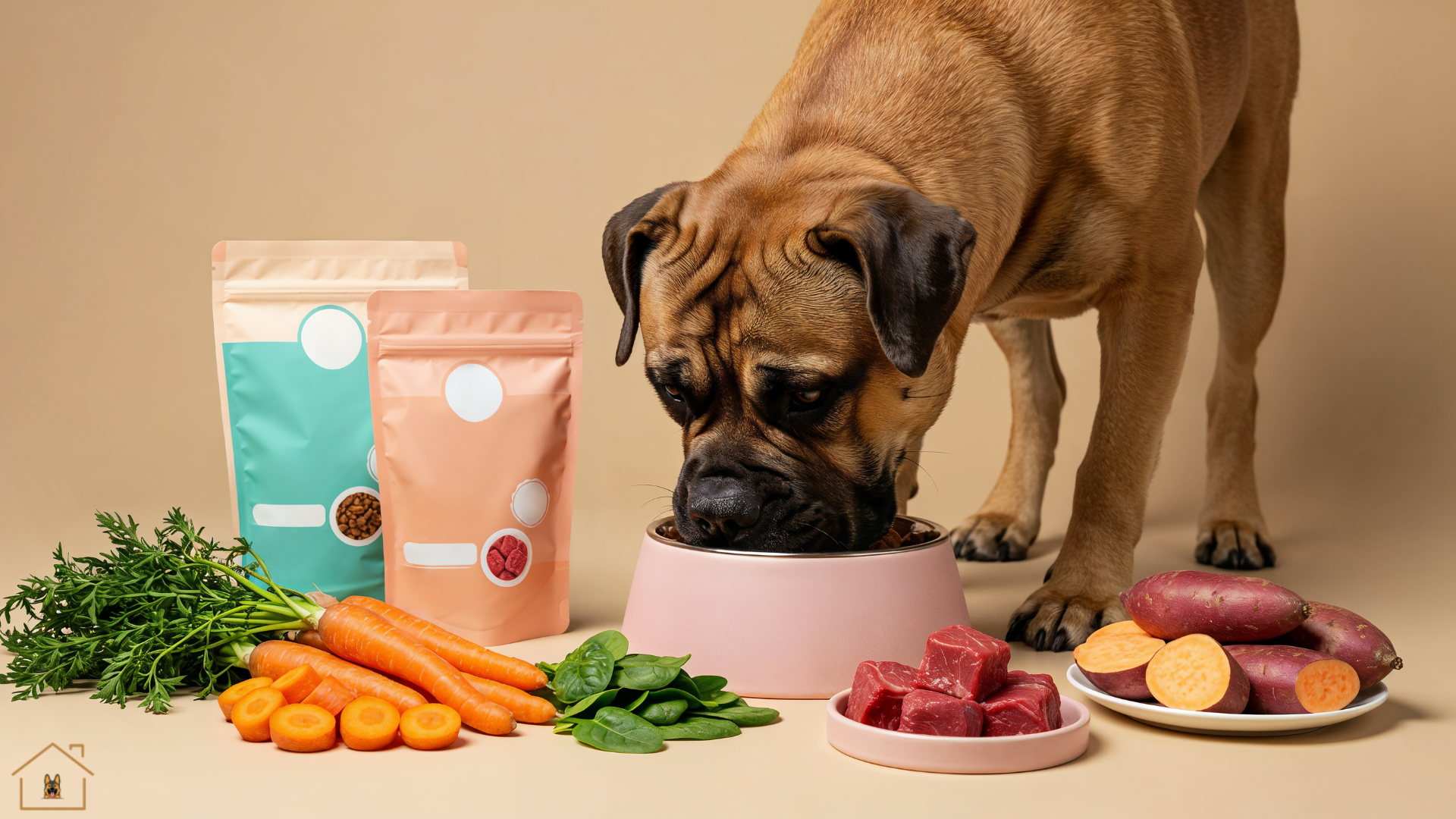High-Fiber Dog Food: Benefits for Digestion + Easy Homemade Recipes
Fiber often doesn’t get the spotlight when we plan our dogs’ meals. As a dog mom who has raised four furry babies, over the years, I, too, used to focus only on protein and healthy fat, at first. But over the years, I have learned fiber is just as important for our canine companions’ health. If your dog struggles with digestion, constipation, or weight issues, fiber can be a game changer — just like other essential dog nutrition basics. As they say, you live and you learn.
If you’re, too, have been wondering, “Is high-fiber dog food good for my dog, and how can I make it at home?”, you’re in the right place. I’ve put together this guide on a high-fiber diet for dogs for pet parents like you. Let’s dive into what high-fiber dog food means, why fiber benefits digestion, and some easy homemade high-fiber recipes you can whip up in your kitchen without slaving for hours.
What Is High-Fiber Dog Food?
Dietary fiber comes from plant parts such as vegetables, fruits, and whole grains that dogs can’t digest. Instead, it helps other foods move smoothly through the digestive tract. “Fiber aids in bowel regularity and gut health, which you can also track by understanding this dog poop guide.”.
“Fiber helps absorb water and adds bulk to stools, keeping your dog’s bowels regular and stools firm.” —Liz Waynick, RVT
A high-fiber diet for dogs simply has more of these food sources than a regular diet. There are two main types of fiber:
- Soluble fiber: Sources of soluble fiber for dogs, like pumpkin, oats, apples, dissolves in water and forms a gel. It feeds good gut bacteria and slows digestion
- Insoluble fiber: Insoluble fiber sources, like in bran, whole grains, carrots, do not dissolve. These add bulk to stool and help food move through the digestive tract.
Since dogs need both, many high-fiber foods mix soluble and insoluble sources. Natural high-fiber foods for dogs include:
- Pumpkin: Vets often use it to ease constipation or diarrhea, and it’s one of the best natural dog constipation remedies.
- Carrots and Green beans: Insoluble veggies that bulk up stool
- Apples and Blueberries: Fruits with soluble fiber plus rich sources of vitamins
- Brown rice and Oatmeal: Whole grains high in insoluble fiber
- Lentils, Chickpeas, Peas: Legumes full of fiber and protein
- Sweet Potatoes: A starchy root high in soluble fiber and vitamin A
Side Note: Supplements like psyllium husk or beet pulp make for good high-fiber dog food for constipation. However, these should only be used when necessary and under the guidance of a vet.
Benefits of High-Fiber Dog Food
A high-fiber diet can make a real difference in your dog’s health. Here are the key benefits:
- Improved digestion: “Improved digestion: Fiber bulks up stool and regulates transit, easing constipation and reducing diarrhea — common dog diarrhea causes & treatment can be managed this way. Liz notes, “Fiber can also reduce diarrhea and constipation symptoms, and improve overall gut health.”
- Weight management:A high-fiber dog food for weight loss is also strongly recommended when your pooch needs to shed a few pounds — here are more dog weight management tips. Because fiber fills a dog up on fewer calories. “Fiber is an excellent nutrient for dogs in need of weight management, helping them feel full while consuming fewer calories,” explains Liz.
- Blood sugar control: Soluble fiber slows the absorption of sugars. For diabetic dogs, this means steadier glucose levels, which aligns with a proper dog diabetes diet. In fact, many vets recommend high-fiber options in dog diabetes diets to regulate glucose absorption
- Anal gland health: Bulkier, well-formed stools naturally press on the anal glands during elimination, helping to express them and prevent impaction
These benefits tie together for overall digestion support and better gut health. High fiber can keep your dog’s gut microbes happy and their stools regular.
| Health Issues | How Fiber Helps |
| Constipation | Insoluble fiber adds bulk and moisture, easing bowel movements |
| Diarrhea | Soluble fiber absorbs excess water, firming up loose stool |
| Obesity/Excess weight | Fiber makes dogs feel full on fewer calories, aiding weight loss |
| Diabetes | Slows sugar absorption to prevent blood-sugar spikes, making fiber an integral part of dog diabetes diet |
| Anal Gland Issues | Bulky stools press on glands to induce natural expression |
| Gut Microbiome | Feeds beneficial gut bacteria for a healthy microbiome |
Signs Your Dog May Need More Fiber
As you can see, every dog stands to benefit from a fiber-rich diet. But is your pet getting enough? If you notice the following signs, your dog may need more fiber in their diet:
- Constipation or irregular stools: Dry, hard, or infrequent stools indicate that your dog’s bowels aren’t moving the way they’re supposed and a low fiber intake may be the culprit
- Frequent diarrhea:Very loose stools, very frequently can also be because of less fiber in a dog’s diet, and learning about dog diarrhea causes can help you understand this better.
- Scooting or anal gland problems: Excessive scooting can mean stools aren’t firm enough to express glands. If you notice your dog do this or strain too hard while pooping, it’s time to up their fiber intake
- Always hungry: If your dog is always hungry and doesn’t seem satiated even after a hearty meal, it may be time to take a fresh look at their food composition. Fiber makes dogs feel full on fewer calories, and when that’s lacking, satiety can be hard to reach
- Unwanted weight gain: Since a lack of fiber can make dogs always beg for food, it can lead to overeating and weight gain
Best Natural Sources of Fiber for Dogs
Some of my favorite dog-friendly fiber sources include:
- Pumpkin: High in soluble fiber. Vets often recommend a spoonful of pure pumpkin for constipation or diarrhea
- Carrots: Crunchy insoluble fiber plus vitamin A. Great raw or cooked
- Green beans: Insoluble fiber and nutrients with almost no calories. Steam them or serve plain
- Apples: Contain pectin fiber and vitamin C. Slice or puree. Do not offer core or seeds
- Blueberries: Tiny fruits packed with fiber and antioxidants. It makes for a healthy treat
- Brown bice: A whole grain rich in insoluble fiber. Gentle on digestion
- Oatmeal: Cooked oats add soluble fiber and energy. And great quick fix for a healthy meal on busy mornings
- Spinach/Kale: Leafy greens providing fiber and micronutrients. Serve lightly cooked and in moderation
- Lentils/Chickpeas/Peas: Legumes full of fiber, protein, and a good source of iron. Cook them thoroughly before feeding
- Sweet potatoes: A starchy root high in soluble fiber and vitamin A
Homemade High-Fiber Dog Food Recipes
I’m a big believer in nutritionally complete home cooked meals for dogs. Cooking at home lets you control every ingredient and skip fillers. It can save money and ensure a high-fiber meal for your dog. Yes, it is a little more time intensive than pouring kibble from a packet but if you prep and plan right, you don’t have to spend hours slaving in the kitchen. Here are three such fiber-rich dog food recipes from my kitchen that you can whip up in a matter of minutes.
Safety Note: Always consult your vet before making major diet changes.
1. Pumpkin and Chicken Rice Bowl—Great for Picky Eaters
Pumpkin for dogs digestion is a well-established gold standard. Plus, they love the sweet taste. The natural sweetness, I mean. Never feed your pet processed pumpkin with added sugars. And chicken is a great lean source of protein. Whether you’re looking for high-fiber dog food for weight loss or homemade high fiber dog food that meets their nutritional needs, this one is a winner.
Ingredients
- 1 cup cooked brown rice
- 1/2 cup pure canned pumpkin with no sugar or spices
- 1/2 cup cooked shredded chicken, without skin
- 1/4 cup peas or carrots, cooked
Steps
- Mix all ingredients in a bowl while warm. The pumpkin adds soluble fiber and moisture
- Let it cool to lukewarm before serving
2. Lentil & Turkey Stew—Slow-cooker Comfort
If you don’t have the time to watch over a pot, slow-cooker recipes for dogs are a great alternative. Combine lentils and turkey to prepare a stew, and you have well-rounded homemade high fiber dog food ready to go.
Ingredients
- 1 cup dried lentils, rinsed
- 1.5 cups water or low-sodium broth
- 1/2 lb lean ground turkey
- 1 carrot and 1 zucchini, diced
Steps
- Brown the turkey, then add lentils, water, and veggies. Simmer 20–30 minutes or until lentils are soft
- Stir in spinach at the end until wilted
- Cool before serving
- This makes about 3–4 cups. Freeze extras
3. Veggie & Oatmeal Fiber Mix—A Quick High-fiber Meal
This is the best high-fiber dog food to whip up in a matter of minutes when you’re short on time but don’t want to compromise on your pet’s nutrition.
Ingredients
- 1 cup cooked plain oatmeal
- 1/2 cup chopped green beans, cooked
- 1/2 cup mixed vegetables. I use peas and carrots
- 2 tbsp cooked pumpkin or sweet potato
Steps
- Combine the warm oatmeal, veggies, and pumpkin in a bowl. Pro Tip: microwaving the oatmeal with steamed veggies can save tim
- Stir in 1 teaspoon of olive oil for healthy fat
- Serve immediately.
Note: Adjust portions for your dog’s size. Always transition your dog to a new diet gradually, over a week or so, to avoid upsetting their stomach.
Store-Bought vs. Homemade: Which is Better?
Commercial high-fiber dog foods like Nutro or Wellness CORE are formulated by nutritionists and continue to be leading vet recommended dog food for high-fiber needs. While homemade meals give you total control of ingredients and can be more budget-friendly, they take time and careful planning. Not all pet parents have that kind of bandwidth.
So, what’s the way out? For a lot of pet parents, a hybrid approach often works well. Feed a quality kibble and add homemade fiber-rich toppers. Some rely solely on packaged foods, others, like me, cook their pet’s meals from scratch. There are no right or wrong answers really. It all boils down to what works best for you and your dog. But if you’re on the fence about which way to lean when looking for the best high-fiber dog food for dogs, this quick comparison might help:
| Factor | Store-Bought High-Fiber Food | Homemade High-Fiber Meals |
| Nutrition | Balanced, vet-formulated diets | Depends on your recipe. Balancing all nutrients is a must |
| Convenience | Ready to serve; long shelf life | Requires cooking/prep |
| Cost | Can be expensive. High-fiber dog food is often premium | Ingredients can be cheaper |
| Ingredient Control | Fixed formula | Full control and no unwanted fillers |
Precautions And When to Avoid High-Fiber Diet
As with any diet change, balance is crucial. Too much fiber too fast can backfire. Liz cautions, “Very high insoluble fiber can bind nutrients and lead to weight loss or a poor coat. Dogs eating excessive fiber may also experience gas, bloating, diarrhea or vomiting.”
Puppies and very young dogs usually need higher protein and may not tolerate excess fiber. Dogs with certain health issues like pancreatitis or severe GI problems might actually need less fiber.Always consult your vet before making any changes to your dog’s diet to avoid any unintended problems.
Takeaway
Adding the right amount of fiber to your dog’s meals can make a big difference in their gut health, digestion, and overall well-being. Liz reiterates, “Incorporating fiber into your dog’s diet can offer a range of health benefits, from improved digestion to better weight management.” Bu t remember, balance is key. Aim for a mix of fiber sources, introduce changes gradually, and always consult your vet. Try some of the recipes above and watch for a happier gut and more regular stools. For more dog nutrition guides and tips, visit AllAboutDogParenting.com to keep your dog happy and healthy.







